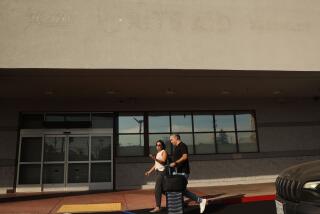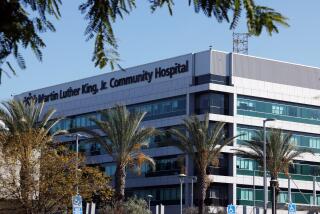Doing Without Hospitals : City Hospitals Not Immune to Financial Woes
CHICAGO — For most of this century, one West Side landmark tended to the sick and suffering and provided for the poor. But the proud hospital finally faced one ailing patient it couldn’t heal: itself.
This was not the fictional St. Eligius closing down in the final season of television’s “St. Elsewhere,” but St. Anne’s Hospital, a real-life anchor in a struggling neighborhood, shutting its doors after 85 years.
Too little income and too much debt proved to be the formula for failure--one being repeated increasingly in hospitals nationwide.
“Most of the people feel they’ve been deserted, walked out on,” said Mary Volpe, a local resident.
“It dampens the spirit of the community,” said Alderman Danny Davis. “It diminishes the quality of life in our community. It diminishes the level of hope.”
Across America, big cities and small towns alike are losing precious hospitals. Health care is changing: Demand for beds is down, costs are up. With fewer paying patients and more reliance on government programs that critics say are too stingy, the nation’s hospital system has reached a breaking point.
“We’re in a health-care crisis,” said Earl Bird, president of the Metropolitan Chicago Healthcare Council, an association of local hospitals. “We’re not heading for anything, we’re in the throes of it.”
Twice in 2 years, record numbers of hospitals have closed: 79 in 1987--17 of them in Texas alone--and 71 in 1986, the American Hospital Assn. says. In the first 10 months of this year, preliminary reports show that 75 more hospitals shut their doors.
The causes cross demographic boundaries: The closings are evenly divided between rural and urban hospitals.
While about 30% of all hospitals are losing money, twice that percentage can show their unstaunched flow of red ink comes specifically from rising costs of patient treatment, said Carol McCarthy, hospital association president.
“That,” she said, “is a fragile hospital system.”
Many cities have experienced the decline. According to health officials:
New York City saw 34 of its 104 hospitals close in 1976-86. Unlike cities with too many vacant beds, New York has 90% occupancy rates, said Ken Raske, president of the Greater New York Hospital Assn. AIDS and drug problems, he said, have prolonged hospital stays.
- From 1983 to the present, 22 of Los Angeles County’s 182 community hospitals have closed or converted to other kinds of care.
- Chicago has seen 10 hospitals fold since 1984. Seven are in areas designated as medically underserved, meaning that they have high infant mortality rates, large elderly populations and too few doctors. Last year, two-thirds of all Chicago hospitals lost money.
Cities, McCarthy said, are seeing a “domino effect”--a hospital serving the poor closes, so people move to another one nearby, which develops the same problems and often suffers the same fate.
“Eventually, you’re going to wind up with a medical wasteland,” said Kenneth Robbins, president of the Illinois Hospital Assn.
The reasons for this collapse aren’t all negative: Americans are living longer, and improved medicine makes most hospital stays shorter or even unnecessary. A patient once hospitalized 12 days for major abdominal surgery, for example, could now be out in three.
But there is plenty of finger-pointing over dollars and cents.
Hospital officials claim that the government has shirked responsibility by underfunding Medicaid, which serves the poor, and Medicare, which serves the elderly.
They say Medicare problems intensified in 1983 after a new system began paying hospitals flat fees according to diagnosis. Some hospitals are also worried by a rule that took effect Nov. 1, reducing the amount Medicare pays for patients who are hospitalized for long periods.
In Illinois, Medicare pays only 89 cents for each dollar of care, while Medicaid pays just 67 cents, Robbins said. State officials insist that their Medicaid share is higher, but won’t say how much.
“For every Medicaid patient a hospital sees, it simply loses more money than if it didn’t see the patient at all,” Robbins said.
Medicaid also can hinder doctor recruitment, Robbins said, because reimbursement is so low. A doctor in a poor neighborhood would have to see three times as many patients as one in a comfortable suburb to earn the same salary.
“This actually encourages Medicaid mills”--doctors writing bogus bills or packing in large numbers of patients for financial gain, he said.
Illinois hospitals gave $600 million in free care last year. About 37 million Americans have no health insurance; in Chicago, it’s 20% of the population.
But state officials say the fault lies not with the government but with the hospitals, which operate inefficiently and haven’t kept pace with a changing society.
“Hospitals like St. Anne’s are the steel mills of the hospital industry,” said Edward Duffy, former director of the state Department of Public Aid. “People don’t use hospitals like they used to.”
Some say both arguments are valid.
‘Tragic Situation’
“It’s one of those tragic situations where everybody is right and everybody is wrong,” said Dr. Quentin Young, professor of preventive medicine at the University of Illinois.
“We have created a two-tiered system,” he said, “people with resources who get the benefits and weaknesses of the system, and 20% and growing who are locked out. That is the tragic dilemma of American health care.”
It’s hit hard in Austin, Chicago’s largest neighborhood with 140,000 residents. The closing of the block-long, 437-bed hospital 2 months ago was one more setback in this predominantly black section that has grappled with crime, white flight, panic peddlers and slum landlords. Now it has lost a major employer--the hospital staff once numbered 650.
Some people also worry that the loss will hurt those who need medical help the most but postpone seeking it until the last minute.
Problem of Insurance
“Poor people do not take time out for preventive health services,” said Jacquelin Reed, chairwoman of the West Side Health Coalition. “If you don’t have any medical insurance, you wait until you have to go to the emergency room.”
The remaining neighborhood hospital, 2 1/2 miles away, provides no obstetric care, and Austin has higher than average rates of sexually transmitted diseases and an infant mortality rate twice the national average.
What doomed St. Anne’s is what has destroyed others.
When it closed, about 70% of its patients were Medicaid recipients; 20% more were Medicare.
Losses were running about $500,000 a month. Had St. Anne’s remained open, they probably would have reached $12 million this year, said Kate Stuckmann, chief operating officer.
Cutbacks Not the Cure
Cutbacks in staff and beds--the hospital had 120 beds open when it closed--weren’t enough. And as doctors left the city, they referred patients to suburban hospitals.
It was a sad end to a hospital that served valiantly in times of tragedy, including a 1958 fire that killed 92 children and three nuns at Our Lady of Angels school.
Even now, 2 months after the closing, “this community is in a state of shock,” said Cynthia Williams, director of the Austin Peoples Action Center. “We basically don’t know what to do if an accident occurs. Austin is in crisis.”
Here are some facts about health care and hospitals provided by the American Hospital Assn., the National Rural Health Assn., the National Hospital Panel Survey, The Texas Hospital Assn. and a survey conducted by the Touche Ross accounting and management consulting firm
CLOSINGS
In 1987, 79 community hospitals closed in 30 states: 35 for profit, 30 nonprofit and 14 owned and operated by the government.
Of those closed, 17 were in Texas, eight others in Arkansas, Oklahoma and Louisiana.
Most hospitals that closed had 25 to 99 beds.
Seventeen non-community hospitals in 13 states also shut down last year. They generally provide specialty care, such as rehabilitative or psychiatric treatment.
FINANCES
Half of all urban hospitals operated in the red in 1987: nearly seven of 10 rural hospitals lost money. Hosptials nationwide lost $2.8 billion in 1980 caring for indigent patients. In 1986, they lost $7 billion
LOCATION
In 1986, more than 46% of the nation’s community hospitals were in rural areas. Of the 2,638 rural hospitals, 71% had fewer than 100 beds.
MEDICARE
The price of goods and services purchased by hospitals from 1984 to 1988 rose 22% , while the amount of Medicare pays to hospitals increased just 11%.
A 1988 survey of 1,400 hospital executives found that 48% think reduced Medicare reimbursements may force their hospitals to shut in the next five years.
HOSPITALIZATION
About 33.6 million people were hospitalized in 1987, an 11% drop since 1982.
AGE (related to Medicare funding)
In 1986, those 65 years and older accounted for 14% of the rural population and 11% of the urban population.
POVERTY (lilnked to Medicare funding)
In 1985, 17.6% of the rural elderly lived in poverty, compared with 10.9% of the urban elderly.
More to Read
Sign up for Essential California
The most important California stories and recommendations in your inbox every morning.
You may occasionally receive promotional content from the Los Angeles Times.










